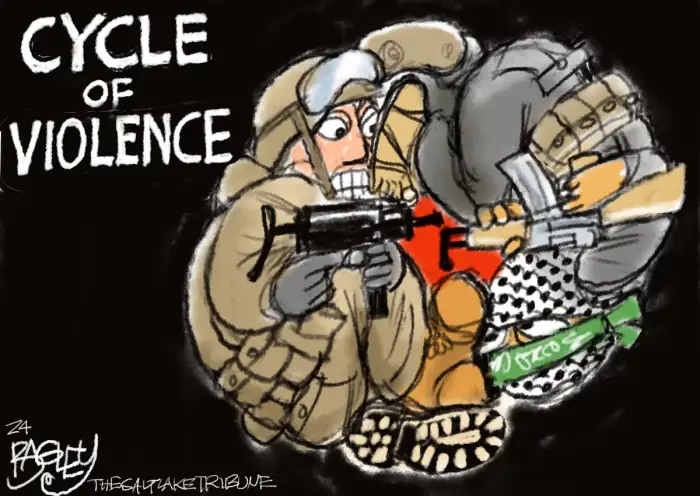Photo: Israel's Defense Minister Yoav Gallant, this month.Credit: Itai Ron
By Yitzhak Brik
Haaretz (Israel's main liberal-centrist daily)
Aug 22, 2024 - Most of the pretentious declarations made by Defense Minister Yoav Gallant throughout the war in Gaza have proven to be groundless.
After the occupation of Gaza City, he said that Israel was in total control of the city and its tunnels, and within a short time, Hamas would surrender. After the occupation of Khan Yunis, he claimed that Hamas leader Yahya Sinwar was running in the tunnels by himself and had lost control of his men, and within a few days he would be caught.
With these pronouncements, Gallant, along with his colleagues IDF Chief of Staff Herzi Halevi and Prime Minister Benjamin Netanyahu, has been throwing dust in the eyes of the Israeli public.
Israel's defense minister isn't a hero. He's just telling the truth
As far as Netanyahu is concerned, Israeli hostages are anything but an asset
Netanyahu's war goal is not the hostages' return. It's the occupation of Gaza
Recently, it appears that Gallant has begun to sober up, when in the Knesset Foreign Affairs and Defense committee he declared that the concept of total victory in Gaza "is nonsense."
And it seems that he has begun to realize that failing to reach a hostage deal with Hamas would lead to a regional war that would put Israel in serious danger.
This realization prompted him to call for a discussion, in the government or security cabinet, intending to warn everyone involved. The apparent goal of the discussion is to ensure that responsibility rests not only on him, but is shared by all the government ministers.
I assume that Defense Minister Gallant already understands that the war has lost its purpose. Israel is sinking deeper into the Gazan mud, losing more and more soldiers as they get killed or wounded, without any chance of achieving the war's main goal: bringing down Hamas.
The country really is galloping towards the edge of an abyss. If the war of attrition against Hamas and Hezbollah continues, Israel will collapse within no more than a year.
Terror attacks are intensifying in the West Bank and inside the country, the reservist army is voting with its feet following recurring mobilizations of combat soldiers, and the economy is crashing. Israel has also become a pariah state, prompting economic boycotts and an embargo on arms shipments.
We are also losing our social resilience, as the growing hatred between different parts of the nation threatens to ignite and bring to its destruction from within.
Sinwar and Hezbollah leader Hassan Nasrallah understand Israel's dire situation. What Israel could have achieved earlier with a hostage/cease-fire agreement has become impossible due to the new conditions that Netanyahu introduced into the proposed deal. Those involved in the negotiations in Doha claim that they have no maneuvering space to negotiate because their hands are tied.
In light of the new situation, a threat by Iran and Hezbollah to attack Israel in response to the killing of the two senior officials is materializing in the region. The use of assassinations is a step threatening to ignite the entire Middle East, decided upon by the three pyromaniacs, Netanyahu, Gallant and Chief of Staff Halevi, without thinking about the significance of their irresponsible decisions.
Sinwar has begun to understand that the war of attrition is working to his benefit, not to mention a multi-arena regional war. That's why he now prefers a continuation of the fighting to a deal, and is toughening his positions. If Netanyahu hadn't already put spokes in the negotiation team's wheels throughout the war, Israel could already have achieved a hostage deal before Sinwar toughened his stance.
Netanyahu's recent announcement to the families of hostages about the need to preserve "security assets" in Gaza – a blatant lie – has effectively torpedoed the deal, leading to a catastrophe not only for the hostages and their families but also for the entire country.
All of the paths chosen by Israel's political and military leadership are leading the country down a slippery slope. One dictator controls the fate of the country, and a flock of sheep follows him blindly. Netanyahu decided to "die with the Philistines" – in this case, the citizens of Israel – only to retain his power.
He has lost his humanity, basic morality, norms, values, and responsibility for Israel's security. Only replacing him and his cronies as soon as possible can save the country. Israel has entered an existential tailspin and could soon reach a point of no return.
After 2,000 years of exile, we returned and established a glorious country. We paid a high price in tens of thousands of dead and wounded. And now the country is disintegrating in our hands through the fault of Netanyahu, Gallant, Halevi, and their pawns. It's still possible to do something before it's too late.
Maj. Gen. Yitzhak Brik served in the Armored Corps as a brigade, division and troops commander, and was the commander of the IDF military colleges. For 10 years he was the Israel Defense Forces ombudsman.







